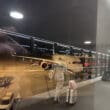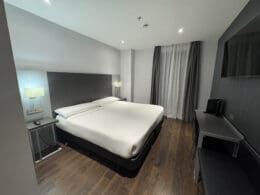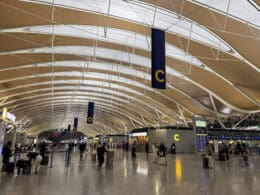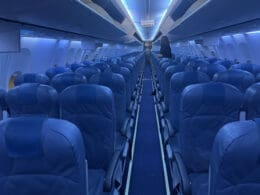Note: This has nothing to do with politics, and all to do with aviation and understanding different cultures. At no point during this post will I address relations between China and the U.S., and this will focus purely on my aviation experience.
In July 2024, I flew from New York LaGuardia to Chicago to Wausau, from Madison to Chicago to Toronto to Newark, and from JFK to London Heathrow. This was more intra-North American flying than I had ever done, since it was my first time in the U.S.. I drafted some of this post straight after my travels, though in the chaos of life, I never got back to it. Here’s my reminiscing now a few months later, obviously with a regime change of sorts in the U.S. having taken place since, which I also won’t get into.
We’ve got a significant U.S. readership here at The Alviator, which I’m really grateful for. This was my first time flying within/out of the U.S. – the internet hears a lot about flying within the U.S. (probably more so than anywhere else in the world), so I thought I’d provide a bit of an outsider viewpoint for readers who have never done it before.
My observation was that the U.S. has a very specific way of doing aviation, and while I was initially anxious, I enjoyed it once I managed to get into the flow of things. I flew flights that millions of Americans fly every week, and gradually got used to some of the quirks you wouldn’t find in the rest of the world. Surprisingly, this reminded me a little bit of flying domestically within China for the first time, where I also felt like there was vast, established structure and automation configured in ways that I had never experienced before. Obviously these quirks are extremely different, but the feeling of unfamiliarity linked my two experiences.
It’s also worth noting that while my travels in the U.S. coincided with the 2024 global aviation IT outage (remember that?), my flights were unaffected. The system went down on Friday, and I flew the night before and the following afternoon. This was a stroke of luck for me, though it does mean I don’t have anything on that front to report back on.
I’ll first note my observations flying intra-U.S., then make the link to domestic Chinese flying at the end of the post.
American and United Mainline: Marginally Better Than Europe
In my view, Europe and the U.S. have both mastered the art of aviation as a transport link down to a T. There’s no denying that neither region’s market standard measures up to southeast Asian carriers, though they’re not trying to pretend like they are.
I’d call the hard product marginally better in the U.S. than in Europe, as the competitive standard features adjustable headrests, 110V power ports, USB ports, and WiFi. This was true of my mainline American flight from New York to Chicago.

American Airlines 737 Economy Class
Meanwhile, my United E175 flight didn’t feature adjustable headrests or power ports, and while there was WiFi, it was much slower. It did the job for the 1h 49m flight from Chicago to Toronto, though.

United Airlines E175 Economy Class
American offered free snacks onboard all of my flights with them (even between Madison and Chicago, which was 175 km), whereas United only offers free snacks onboard flights above 300 miles. I believe I slept through the meal service on United, though did finally get to see the intra-U.S. biscoff craze that millions of Americans associate with flying.

Biscoff – a staple of flying for many Americans, but not this Asian man
This is on a similar bar to flying intra-China – generally lots of narrowbodies with occasional “hidden gem” widebody routes (see my China Southern review for an example). I think the U.S. does tech better, but Chinese carriers generally feature a better soft product.
The TSA and Border Security: Not Great and Unpredictable, but Functional
I was screened at New York-LaGuardia, Madison Airport, and JFK Terminal 5, and also saw a friend through the regular (non TSA Pre-Check) line at JFK Terminal 8. None of these airports offered particularly good experiences, and JFK T5 pulled up the rear, with a 20-minute wait from the priority line during peak rush hour. As a tourist, I also didn’t have access to TSA Pre-Check.
That being said, apart from the need to take your shoes off, I didn’t think it was too far from a non-efficient large airport in Europe? Airports are generally pretty good with providing live TSA wait times for you to know what you’re walking into, and the queues moved quickly (the regular queues moved much quicker than the priority queue at JFK T5, albeit being much longer). I’m aware that a “bad” day in the U.S. can be much worse than a bad day anywhere else in the world, though I didn’t experience anything horrendous on my mid-July trip.

LaGuardia provided a surprisingly long wait time at security, with it taking around 25 minutes
I also appreciated that you only had to go through security once when flying domestically, so there was no need to clear from a sterile arrivals area to a sterile departures area when transiting. This made the experience somewhat akin to flying within the Schengen region.
Chicago O’Hare: Boring (But Not Unpleasant) Passenger Experience, And Looks Like A Prison
The airport I spent by far the most time at during my trip was Chicago O’Hare Airport, an airport that I’d heard many things about since I was young. I’d heard many middling things about the airport as I grew up, and had the sense that it wasn’t an American favourite.


Chicago O’Hare Airport
Well, how was it? I couldn’t get over the fact that much of the airport looked and felt a bit like a prison. While slightly more aesthetically designed, even the newest “Stinger” concourse built in 2018 was quite drab and devoid of amenities.


Chicago O’Hare Airport “New” L Concourse
I understand that the Rotunda building was under renovations when I was there, though this sums up what Chicago O’Hare Airport felt like…

Chicago O’Hare Airport Rotunda Building (or Lack Thereof)
Despite all this, I felt that the airport was easy to navigate (albeit the total lack of travelators) and signage was good – while a drab and boring airport experience, I didn’t feel like it was unpleasant.
A Crazy Number of Boarding Groups
One thing I noticed was that both American and United had a ton of boarding groups. American Airlines had the most with 9 boarding groups (that’s 2.25 boarding groups per cabin class), and United had 7 boarding groups, including pre-boarding.

American Airlines has 9 (!) boarding groups
Adherence to boarding groups was impressive, considering how many times I’ve seen people outright ignore them in other countries.
The CRJ200: Glad To Fly Them, But Glad They’re Over
Two of my flights were to Wisconsin (I flew from Chicago to Wausau, then from Madison back to Chicago). Back at the time American Eagle had a partnership with Air Wisconsin, which they’ve since cut as of early this month – this meant that both flights to Wisconsin were on Air Wisconsin-operated CRJ200s. I’m glad to have flown the plane, though missed having the ability to bring my carry-on onboard, as well as the ability to stand up without hitting my head on the ceiling. Not to mention that we had a tornado pass through while we were still at O’Hare, so it was a bumpy ride from Chicago to Wausau.
Both of these flights are now operated by Embraer E170s, which are much more pleasant to fly.


American Eagle’s CRJ200s, which now fully belong to Air Wisconsin again
Tornado warning at O’Hare?
As a warm welcome to the Midwest, we were graced with a tornado warning a few hours into my transit at O’Hare, which meant that we all had to take cover. I found it quite funny that we were all herded to a tornado shelter area that was right next to an outdoor-facing door that had a built-in window (given that we were in a bus gate waiting area), and airport staff would regularly head outdoors while the rest of us took cover.

To the tornado shelter we go!
The tornado warning and bad weather at O’Hare ended up delaying our flight by a couple of hours (apparently the tornado went right through the airport tarmac, though it seemed quite “business as usual”), though our flight did end up operating eventually. I was thankful for this, since our flight was the last to go out to Wausau that night.
American aviation does have a very specific service culture
I’d say that almost without exception, most employees I interacted with when flying domestically appeared quite curt and barked orders loudly, though they provided an exceptional amount of detail whenever there were any delays, and were very nice whenever I interacted (politely) with them.
Aviation service culture gets a particularly bad rep in America, though from TSA agents to gate agents, I can see that everyone just wants to get the job done and get passengers sent on their way. Flying can sometimes be frustrating for everyone, and clarity is valued over esteem in this case – loudly making clear what passengers could expect triumphed over announcing calmly on the PA about “we will provide further information whenever it is available”, which is consistent with my understanding of professional culture in America vs. the rest of the world (which is an overly crude simplification, though hopefully valid in this particular case). Of course, this isn’t always 100% the case, and I’m sure there are cases of people genuinely being rude or ungracious, but that’s the experience I got out of everyone I interacted with on the whole.
When navigating changes and cancellations when flying within the U.S., polite and clear does the trick – know what you want out of each conversation – employees aren’t a frustration vent for you, but they can genuinely help you rebook your flight if you’ve figured out a different option.
Hear me out…
Flying within the U.S. involved familiarising myself with a new service culture, new norms, and new unspoken rules. As I mentioned in the beginning of the post, it kind of reminded me of my first time flying domestically within mainland China in 2015 (or 2017, where I also flew domestically within mainland China).
Preposterous? Yeah, probably. Millions of people on the internet are used to flying regularly within the U.S., and wouldn’t dream of the experience being compared to flying within China. But as someone who grew up in Hong Kong (which I wouldn’t consider is a similar experience to flying domestically within China, since it has completely different norms and regulations), both markets are not hugely seen as luxurious experiences, and required me moving out of my comfort zone to adjust to a life that many people live on a weekly basis. When comparing the TSA and having biscoff cookies onboard flights, to Chinese airlines serving lao gan ma and adhering to random rules (such as not being able to use mobile phones onboard) not recognised by any other country, both experiences felt like I was a newbie/foreigner acclimating to being part of a well-oiled machine.
Of course there are major differences – flying within the U.S. felt much more approachable, whereas the actual provided service is much better on Chinese airlines (with hot meals on flights being the norm). However, familiarity works in funny ways, and two cultures normally hostile and completely at ends with each other can feel similar to a third party in the oddest of ways.

Of course I’m not saying that we should Shenzhen Bao’an Airport to O’Hare 2.0, though there are remarkable similarities between experiences at Chinese and American airports
Conclusion: My First Time Flying Within The U.S.
Flying within the U.S. was super fun. I’ve noted a few of my observations above, and I’m very keen to do it again soon. Remarkably, I found the experience somewhat similar to the first time I flew domestically within China – less because the experiences were identical, and more because I felt like I was a foreigner acclimating to being part of a well-oiled machine.
Do you agree with this parallel, especially if you’ve done both a bit of intra-U.S. and intra-China flying?










The photos from O’Hare airport in Chicago are from the terminals that date back to the 1960’s. Terminal 5 and Terminal 1 where United has most of its operations are newer but not new. That is why the ceiling height is low.
One advantage of the American system is that many small and medium sized cities can be reached with only one connection and a connection time of between one and two hours. For example, Columbia, South Carolina to Wichita, Kansas or Syracuse, New York to Albuquerque, New Mexico. Nearly all flights do not require walking outside to get on the airplane.
Yes I loved this! A 15-minute connection really is possible here. It feels like catching a train, until you get caught out by being in group 7 for boarding.
Thanks for sharing – I truly enjoy reading the opinions of non-Americans on our culture, since it is fascinating to me to learn what others find good/bad/strange that we find completely normal. We can be a haughty bunch! 😉
Thanks for your write-up. Outstanding!
And in the final analysis…maybe the US and China have most everything in common. We are all humans, after all…
It’s ppl like Trump/ Vance, and their minions, that cause problems for every human…just for their own personal benefit and enrichment.
As a US-American I apologize.
Great review from a different perspective. Being from the USA, I always enjoy flying foreign airlines over domestic.
I am not sure if you noticed, but pilots on US airlines have a tendency to leave the seatbelt sign on even during smooth air. It is really out of hand. Some say that sometimes the flight attendants will ask them to do that, so that they don’t have to provide as much service.
Also on the travelators, most of the US airports that had them have removed them. The reason being—-it takes away from people visiting the retail outlets that they pass by!!!! You can’t make this stuff up. I am not sure about ORD, but I know that MCO and DFW have removed them for those reasons.
I have never flown a Chinese airline (although, funnily enough, one of my brothers flew for Air Macau and another for Vietnam Airlines) but I travel enough to Europe to agree with your intake. I’ll add a couple things: one, airplane seats in European airlines are much less cushioned, to the point of some being truly uncomfortable, and two, at the airports it’s harder to come across restrooms and, when you finally find one, the number of stalls is minimal.